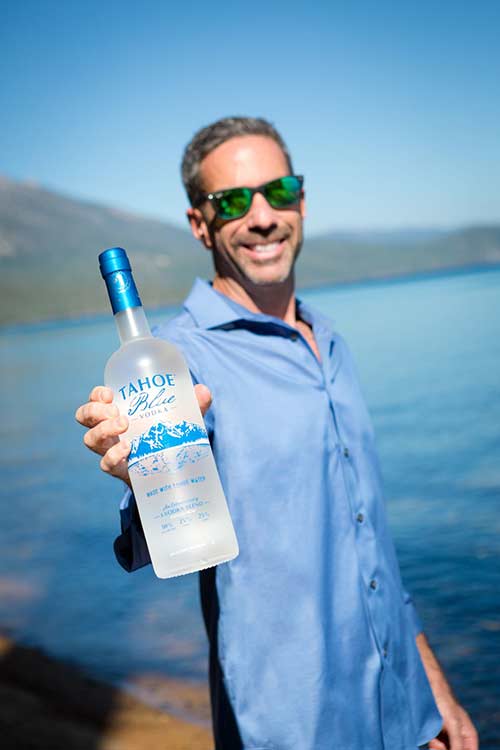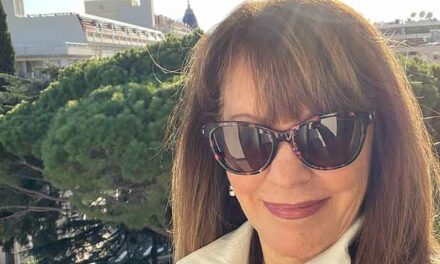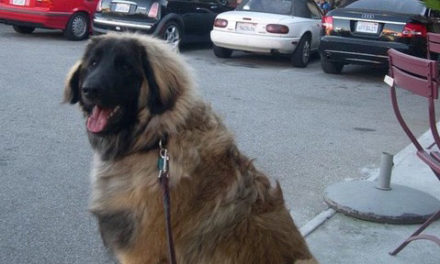Tahoe Blue Vodka: A Deep (And Successful) Dive For Its Founder
Lake-sourced, grain-less drink is already in 4,000 stores
By Ed Goldman
Matt Levitt’s tagline for his grain-free vodka is almost as refreshing as the drink itself: “Tahoe Blue Tastes Better.”
In just four words, he manages to say about Tahoe Blue what other manufacturers of spirits, wine, coffee and cigars spend paragraphs on, in the process giving you the product’s pedigree, birthplace, philosophy, religious persuasion and possibly, sexual orientation.
Matt Levitt with his signature product at his signature lake
Meanwhile, all you really want to know is: How does it taste?
Tahoe Blue’s tagline may be deceptively low-key—Levitt says “It’s a surprisingly easy concept to sell”—but it’s also highly accurate. As a confirmed vodka martini-phile of many years, I can tell you that Tahoe Blue is versatile: It can stand up to vermouth (or the lack of same), to tonic water, seltzer, ice cubes; being shaken, stirred or otherwise aggravated. It also has something most vodkas don’t unless the manufacturer sends out a version that contains (and I’m not making this up) raspberries, chocolate or marshmallows: a distinctive and crisp taste.
That the water used to produce Tahoe Blue is sourced from the spectacular California/Nevada lake of the same name may help to inform the vodka’s “clean” affect. Confirmed vodka drinkers have said for years that what they like best about the drink is the alcohol’s very lack of insistency. Also, that if a cop pulls you over, he or she may have a harder time detecting vodka on your breath—as opposed to gin, which smells like you’ve been gargling Jade East; beer, just one of which gives you the aroma of a brewery, unmucked horse stall or fraternity urinal; most wines; and certainly the “brown” alcohols like Scotch, rye, bourbon, and even tequila, which I guess tends to give off more of an amber alert.
It should be noted that Levitt is deeply involved in cleaning up his product’s namesake lake. I’m being literal when I say “deeply”—he’s a SCUBA diver. Levitt and a dedicated cadre of divers have been removing 20,000 pounds of trash from Lake Tahoe’s bed since May of this year, circumnavigating 72 miles of the shoreline. Levitt smiles and calls it “a very slow-moving process when humans do it. But you can already see the difference in the water.” His company has donated more than $100,000 to the effort.
Cleaning up Lake Tahoe has been as much a personal as professional mission for Levitt, who’s 44 years old, the father of three daughters—Layla, who’s 15; Abby, 13; and Brynn, 8—and a half-time resident of South Lake Tahoe, dividing his time between the resort town and Sacramento’s central city.
When he was growing up in a lower- middle-class home in Baltimore, Maryland, his schoolteacher mom, Kay, was the family’s sole support since his father had a number of physical challenges (and would die at the age of 52). “From the time I was a kid, I always wanted to see the American west someday,” he tells me, his eyes lighting up as they must have back then at imagining wider-open, greener spaces and bluer skies than the urban grayness in which he was being raised. “I wanted to see San Francisco, the Grand Canyon and maybe most of all, Lake Tahoe.” At 23, he went on a road trip, saw and embraced his promised land (and lake) and never looked back. He found work in a variety of sales jobs, where Levitt’s seemingly innate talents as a marketer saw him working for or co-owning small businesses, including a paint store franchise.
Levitt admits he’s a business wonk: someone who pored over spread sheets, business plans and return-on-investment data before leaping into the rarefied air of the spirits industry, where success can be as elusive as a perfect martini. “Ninety-one percent of all the spirits industry market share was controlled by two big distributors,” he says, explaining how, when he did the math, he was likely to be more profitable from distributing than distilling the vodka he developed. “So I became my own distributor,” he says, barely conveying the enormous leap of self-confidence it took to craft then personally market his creation.
“I’d look in the mirror some mornings,” he says, “and say to the guy looking back at me, ‘This is going to work. Don’t worry. ‘”
It turned out to be a nice reflection on him. Today, Tahoe Blue is sold in 4,000 stores across Northern California and Nevada, where the brand’s name may be an instant source of regional pride, but has people sticking around for the taste.
While Levitt clearly adored and admired his parents—his mom now lives in Tahoe—he says that his business inspiration was his grandfather, Ben, “who was one of the first Jews to graduate from the U.S. Naval Academy, flew anti-enemy-submarine warfare missions, retired as a commander from the Navy and then built a hugely successful government research group: a think tank dealing with high-security developments.”
Levitt takes a breath, “He was my idol,” he says simply, with no need to sell the concept.
Ed Goldman's column appears almost every Monday, Wednesday and Friday. A former daily columnist for the Sacramento Business Journal, as well as monthly columnist for Sacramento Magazine and Comstock’s Business Magazine, he’s the author of five books, two plays and one musical (so far).













